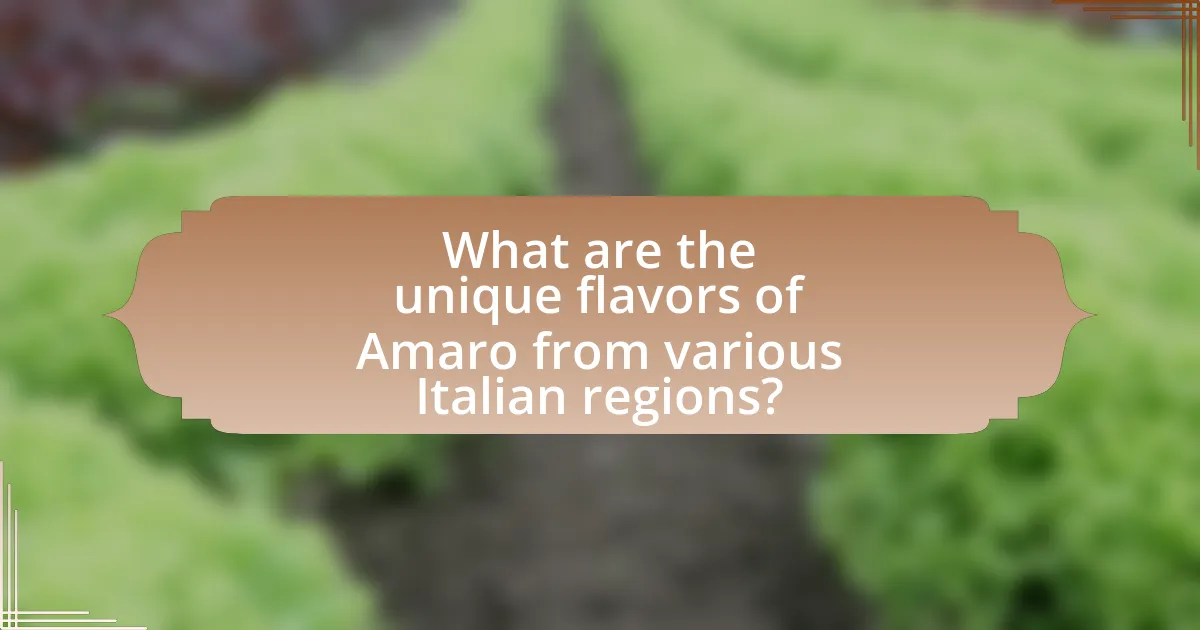Amaro is a traditional Italian herbal liqueur known for its bittersweet flavor and cultural significance as a digestif. The article explores the production process of Amaro, highlighting the maceration of various herbs, spices, and citrus peels, which varies by region, resulting in distinct flavor profiles. It discusses the role of Amaro in Italian gastronomy, its consumption practices, and food pairings that enhance the tasting experience. Additionally, the article examines notable brands from different regions, current trends in Amaro consumption, and innovations in the market, providing a comprehensive overview of this integral aspect of Italian culinary heritage.

What is Amaro and its significance in Italian culture?
Amaro is a traditional Italian herbal liqueur characterized by its bittersweet flavor, typically consumed as a digestif. Its significance in Italian culture lies in its deep-rooted history, often associated with family recipes passed down through generations, and its role in social gatherings and meals, reflecting regional identities and local ingredients. Amaro is not just a beverage; it embodies the Italian ethos of savoring life, enhancing culinary experiences, and celebrating communal traditions.
How is Amaro traditionally made?
Amaro is traditionally made through a process of maceration, where a base spirit, typically neutral grain alcohol, is infused with a variety of herbs, spices, roots, and citrus peels. This infusion process allows the flavors and aromas of the botanicals to meld with the alcohol, creating a complex and aromatic liqueur. The mixture is then sweetened with sugar or syrup and often aged in barrels to enhance its flavor profile. Historical records indicate that the origins of Amaro date back to the 19th century in Italy, where it was initially crafted for medicinal purposes before evolving into a popular digestif.
What ingredients are commonly used in the production of Amaro?
Amaro is commonly produced using a variety of ingredients, including herbs, spices, roots, and citrus peels. These components contribute to the complex flavor profile of Amaro, with specific recipes often incorporating ingredients such as gentian root, wormwood, orange peel, and various aromatic herbs. The use of these botanicals is rooted in traditional Italian practices, where each region may emphasize different local ingredients to create unique variations of Amaro. For example, some Amari may feature ingredients like saffron or myrtle, reflecting the regional flora and culinary traditions.
How does the production process vary across different regions?
The production process of Amaro varies significantly across different Italian regions due to local ingredients, traditional methods, and climatic conditions. For instance, in the northern regions like Trentino-Alto Adige, producers often use alpine herbs and spices, reflecting the mountainous terrain, while in southern regions such as Sicily, citrus peels and aromatic plants are more prevalent, influenced by the warmer climate. Additionally, the maceration and aging processes differ; some regions may favor longer aging in oak barrels, which imparts distinct flavors, while others might use stainless steel to preserve the freshness of the botanicals. This regional diversity is supported by the Italian law that allows for variations in production methods, leading to a wide range of flavor profiles and characteristics in Amaro.
What role does Amaro play in Italian gastronomy?
Amaro serves as a crucial component in Italian gastronomy, primarily functioning as a digestif that aids digestion after meals. This herbal liqueur, characterized by its complex flavors derived from a blend of botanicals, roots, and spices, is traditionally consumed neat or on the rocks. The significance of Amaro is underscored by its regional variations across Italy, each reflecting local ingredients and cultural practices, thus enhancing the culinary experience. For instance, Amaro Averna from Sicily and Fernet-Branca from Lombardy showcase distinct flavor profiles that contribute to Italy’s rich gastronomic diversity.
How is Amaro typically consumed in Italy?
Amaro is typically consumed in Italy as a digestif, served neat or on the rocks after meals to aid digestion. This tradition stems from the herbal and bitter profile of Amaro, which is believed to stimulate digestive enzymes. In addition to being enjoyed straight, Amaro is also commonly used in cocktails, showcasing its versatility in both casual and formal dining settings.
What food pairings enhance the experience of drinking Amaro?
Food pairings that enhance the experience of drinking Amaro include rich cheeses, dark chocolate, and cured meats. These foods complement the herbal and bitter notes of Amaro, creating a balanced tasting experience. For example, aged cheeses like Parmigiano-Reggiano or Gorgonzola provide a savory contrast, while dark chocolate adds a touch of sweetness that harmonizes with the drink’s complexity. Cured meats, such as prosciutto or salami, introduce saltiness that enhances the Amaro’s flavors, making the overall experience more enjoyable.

What are the unique flavors of Amaro from various Italian regions?
Amaro from various Italian regions exhibits distinct flavors influenced by local botanicals and traditions. For example, Amaro Averna from Sicily is known for its sweet, herbal profile with hints of citrus and spices, reflecting the island’s rich agricultural heritage. In contrast, Amaro Montenegro from Emilia-Romagna features a complex blend of 40 botanicals, offering a balance of sweetness and bitterness with floral and citrus notes. Meanwhile, Amaro Nonino from Friuli-Venezia Giulia is characterized by its unique use of grape distillate, resulting in a smooth, fruity flavor with a hint of bitterness. Each region’s Amaro showcases local ingredients and cultural influences, contributing to the diverse landscape of Italian herbal liqueurs.
How do regional ingredients influence the flavor profiles of Amaro?
Regional ingredients significantly influence the flavor profiles of Amaro by imparting distinct botanical characteristics and local nuances. For instance, Amaro produced in the Alpine regions often features herbs like gentian and juniper, which contribute to a more bitter and aromatic profile, while those from coastal areas may incorporate citrus peels and sea herbs, resulting in a fresher and lighter taste. The use of local spices, fruits, and botanicals not only reflects the terroir but also aligns with traditional recipes, enhancing the authenticity and complexity of each Amaro. This regional diversity is evident in the wide range of flavor profiles, from the sweet and herbal notes of Amaro Nonino from Friuli to the bitter and earthy flavors of Amaro Averna from Sicily.
What are the distinctive characteristics of Amaro from Northern Italy?
Amaro from Northern Italy is characterized by its herbal complexity, pronounced bitterness, and often a higher alcohol content compared to other regions. This style typically incorporates local botanicals such as gentian, wormwood, and various aromatic herbs, which contribute to its unique flavor profile. Additionally, Northern Italian Amari often exhibit a more pronounced sweetness balanced with bitterness, resulting in a rich and layered taste experience. The use of high-quality ingredients and traditional production methods further enhances the distinctiveness of these liqueurs, making them a notable representation of the region’s culinary heritage.
What flavors are prominent in Amaro from Southern Italy?
Amaro from Southern Italy prominently features flavors such as bitter herbs, citrus, and spices. These flavors are derived from a variety of botanicals, including gentian, orange peel, and various aromatic herbs, which are commonly used in the production of these liqueurs. The bitterness is often balanced by sweetness, creating a complex flavor profile that is characteristic of Southern Italian amari. For example, brands like Amaro Averna and Amaro Lucano showcase these distinct flavors, reflecting the regional ingredients and traditional recipes that define Southern Italian amaro.
What are some notable brands of Amaro from different regions?
Notable brands of Amaro from different regions include Amaro Montenegro from Emilia-Romagna, Fernet-Branca from Lombardy, and Amaro Averna from Sicily. Amaro Montenegro, created in 1885, is known for its herbal and citrus notes, while Fernet-Branca, established in 1845, is recognized for its intense bitterness and complex flavor profile. Amaro Averna, originating in 1868, features a sweeter taste with hints of caramel and herbs, reflecting Sicilian traditions. These brands exemplify the diverse flavor profiles and regional characteristics of Amaro in Italy.
Which brands represent the best of Northern Italian Amaro?
The brands that represent the best of Northern Italian Amaro include Amaro Montenegro, Averna, and Amaro Nonino. Amaro Montenegro, established in 1885, is renowned for its complex flavor profile, which includes a blend of 40 botanicals. Averna, originating from Sicily, is known for its rich, herbal taste and has been produced since 1868. Amaro Nonino, created in 1933, is celebrated for its unique use of grape distillate and a balanced mix of herbs and spices. These brands exemplify the diverse and rich tradition of Amaro in Northern Italy, each offering distinct flavors that reflect the region’s heritage.
What Southern Italian Amaro brands are gaining popularity?
Southern Italian Amaro brands gaining popularity include Amaro Montenegro, Amaro Lucano, and Amaro Averna. Amaro Montenegro, known for its complex flavor profile with hints of orange and spices, has seen a rise in demand due to its versatility in cocktails. Amaro Lucano, with its rich herbal notes and a history dating back to 1894, has also gained traction among consumers seeking authentic Italian experiences. Amaro Averna, recognized for its smoothness and balanced sweetness, has become a favorite in both bars and homes, contributing to its increasing popularity. These brands reflect a growing interest in traditional Italian herbal liqueurs, appealing to both new and seasoned Amaro enthusiasts.

How can one appreciate and enjoy Amaro?
To appreciate and enjoy Amaro, one should explore its diverse flavor profiles by sampling different brands and styles from various Italian regions. Each Amaro has unique botanical ingredients and production methods that contribute to its distinct taste, such as the herbal notes in Amaro Montenegro from Emilia-Romagna or the citrus flavors in Amaro Averna from Sicily. Tasting Amaro neat or on the rocks allows for a full experience of its complexity, while pairing it with complementary foods, like rich cheeses or dark chocolate, enhances the overall enjoyment. Additionally, understanding the history and cultural significance of Amaro in Italian tradition can deepen appreciation, as it is often consumed as a digestif after meals, reflecting its role in Italian culinary customs.
What are the best practices for tasting Amaro?
The best practices for tasting Amaro include using a proper glass, observing the color, inhaling the aroma, taking small sips, and noting the flavor profile. Using a tulip-shaped glass allows for better aroma concentration, enhancing the tasting experience. Observing the color can provide insights into the ingredients and aging process, as darker Amari often indicate richer flavors. Inhaling the aroma before tasting helps identify the herbal and botanical notes present. Taking small sips allows for a more thorough exploration of the complex flavors, which can include bitterness, sweetness, and herbal characteristics. Noting the flavor profile involves recognizing the initial taste, mid-palate complexity, and finish, which can vary significantly among different Amari, reflecting their regional origins and unique recipes.
How should Amaro be served for optimal flavor experience?
Amaro should be served chilled or at room temperature to optimize the flavor experience. Serving Amaro chilled enhances its aromatic complexity and balances its bitterness, making the herbal notes more pronounced. Additionally, it can be enjoyed neat, on the rocks, or as part of a cocktail, allowing for versatility in flavor profiles. The traditional Italian practice often involves serving Amaro after meals as a digestif, which complements its digestive properties and enhances the overall tasting experience.
What tips can enhance the enjoyment of Amaro cocktails?
To enhance the enjoyment of Amaro cocktails, consider using fresh ingredients and garnishes that complement the herbal and bitter notes of Amaro. Fresh citrus, such as lemon or orange, can brighten the flavors, while herbs like mint or basil can add complexity. Additionally, serving Amaro cocktails over ice can chill the drink and mellow the bitterness, making it more palatable. The use of high-quality mixers, such as tonic water or soda, can also elevate the overall experience by balancing the Amaro’s intensity. These tips are supported by the fact that fresh ingredients and proper serving techniques are known to enhance the sensory experience of cocktails, as highlighted in various cocktail preparation guides.
What are some common misconceptions about Amaro?
Common misconceptions about Amaro include the belief that it is solely a digestif, when in fact it can be enjoyed in various cocktails and settings. Additionally, many people think all Amari are overly bitter, but the flavor profiles vary widely, with some being sweet or herbal. Another misconception is that Amaro is exclusively Italian; while it has strong Italian roots, similar herbal liqueurs exist globally. Lastly, some assume that Amaro is only for older generations, but its popularity is rising among younger drinkers who appreciate craft cocktails.
Why is Amaro often misunderstood as just a digestif?
Amaro is often misunderstood as just a digestif because many people associate it solely with its traditional role in aiding digestion after meals. This perception overlooks the complexity and versatility of Amaro, which varies significantly in flavor profiles, ingredients, and uses across different Italian regions. For instance, while some Amari are indeed consumed after dinner, others are enjoyed as aperitifs or in cocktails, showcasing their broader culinary applications. The rich history and regional variations of Amaro, such as the herbal and bitter notes found in Amaro Montenegro from Emilia-Romagna or the sweeter, citrus-infused flavors of Amaro Averna from Sicily, further illustrate that it is not limited to a single function.
How does the perception of Amaro differ internationally?
The perception of Amaro varies significantly across international markets, with some regions embracing it as a sophisticated digestif while others view it as a niche or unfamiliar product. In Italy, Amaro is deeply integrated into dining culture, often enjoyed after meals, whereas in the United States, it has gained popularity in craft cocktails, appealing to a younger demographic seeking unique flavors. In countries like Germany, Amaro is recognized for its herbal qualities and is sometimes used in traditional remedies, reflecting a different cultural appreciation. This divergence in perception is influenced by local drinking customs, culinary traditions, and marketing strategies that shape consumer awareness and acceptance of Amaro.
What are the current trends in Amaro consumption?
Current trends in Amaro consumption indicate a growing interest in craft and artisanal brands, with consumers increasingly favoring unique, region-specific flavors. This shift is evidenced by a 2022 report from the IWSR, which noted a 15% increase in Amaro sales in the U.S. market, driven by a younger demographic seeking authentic and diverse drinking experiences. Additionally, the rise of cocktail culture has led to Amaro being featured prominently in bars, with mixologists incorporating it into innovative cocktails, further enhancing its popularity.
How is the craft cocktail movement influencing Amaro popularity?
The craft cocktail movement is significantly increasing Amaro popularity by promoting the use of unique and artisanal ingredients in cocktails. This movement emphasizes creativity and quality, leading bartenders to explore Amaro’s complex flavors and incorporate them into innovative drink recipes. For instance, the rise of craft cocktail bars has resulted in a 20% increase in Amaro sales in the United States from 2015 to 2020, as reported by the Distilled Spirits Council. This trend showcases how the craft cocktail culture not only elevates Amaro’s profile but also encourages consumers to appreciate its diverse regional characteristics and flavor profiles.
What innovations are emerging in the Amaro market?
Innovations emerging in the Amaro market include the introduction of unique flavor profiles, the use of local and organic ingredients, and the development of low-alcohol and non-alcoholic alternatives. Producers are increasingly experimenting with botanicals and herbs native to specific Italian regions, enhancing the diversity of flavors. For instance, brands are incorporating unusual ingredients like saffron and citrus peels to create distinctive blends that reflect regional characteristics. Additionally, the trend towards sustainability has led to a focus on eco-friendly production methods and packaging, appealing to environmentally conscious consumers. These innovations are reshaping the Amaro landscape, making it more accessible and appealing to a broader audience.










